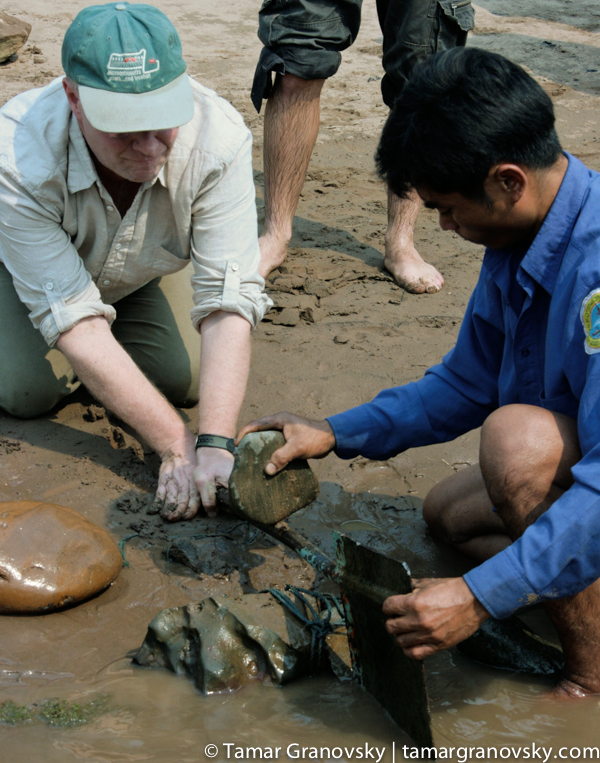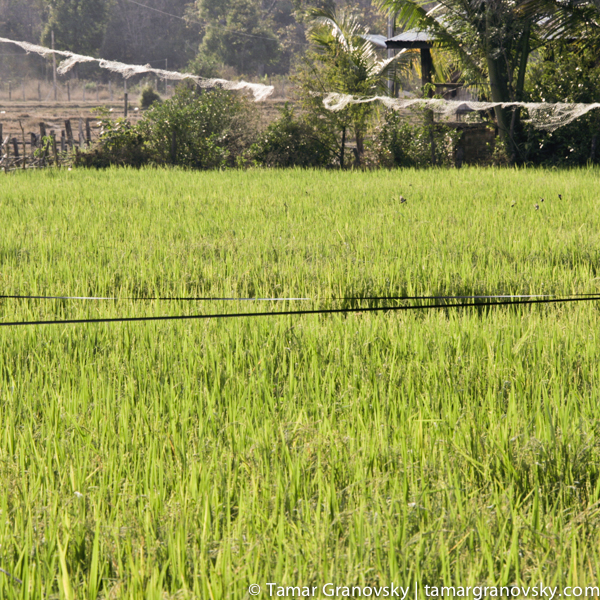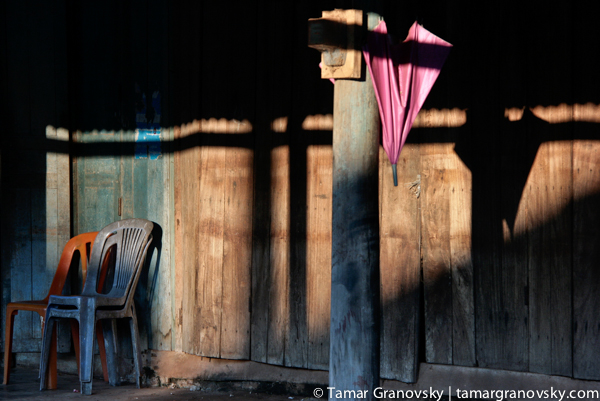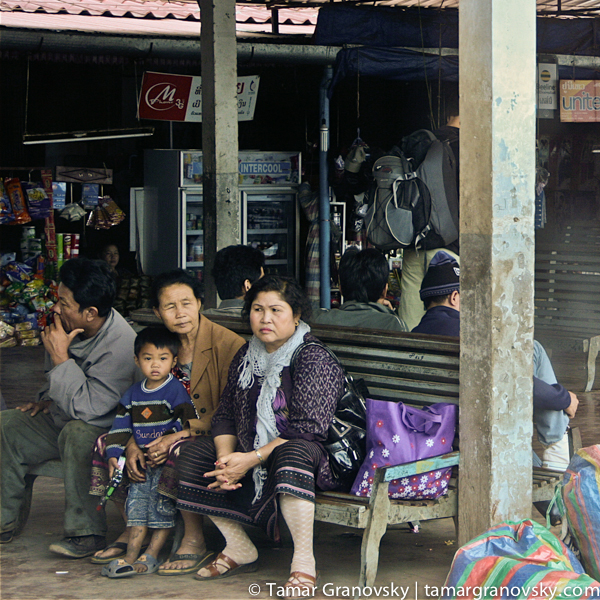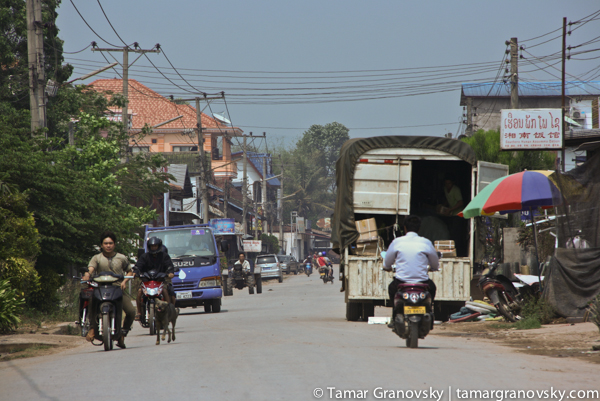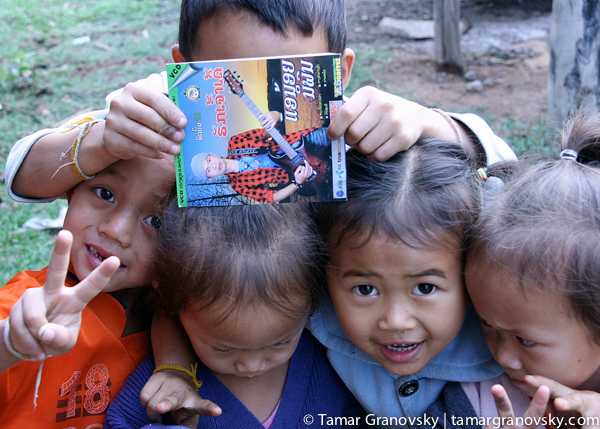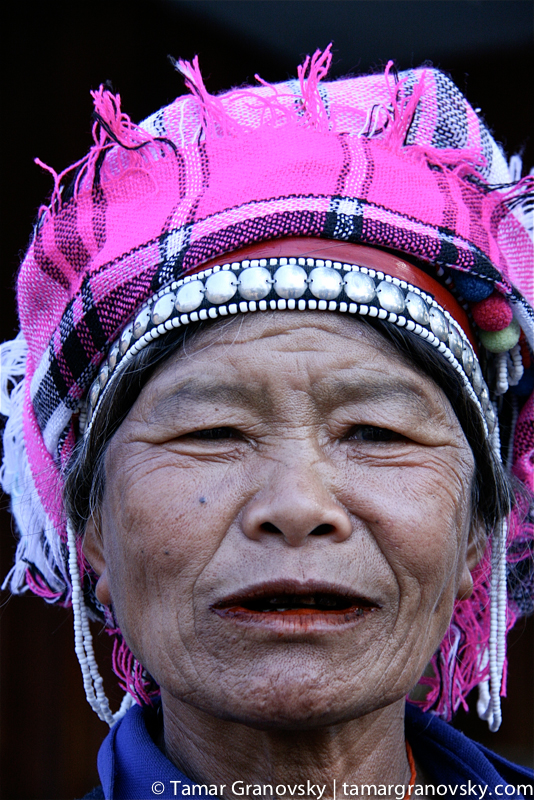2010
Luang Prabang
Luang Prabang, located on a peninsula, lies between the Nam Khan (nam means river and water in Lao) and the Mekong River. It is a charming, but touristy town and is a Heritage site filled with monks dressed in orange robes, golden wats (temples), and French influenced buildings from when the city was colonized. In March, the time of our visit, the city is surrounded by a smokey haze from slash and burn agriculture. Farmers burn brush off their land so that they can then plant rice and other crops at the start of May.
Steve and I walked the city our first day in Luang Prabang doing the tourist thing (taking photographs of monks, markets, and many other sites). We had two and a half days before our planned trip to Nong Kiau via slow boat up the Nam Ou.
A few observations:
— There is the smell of burning flesh (lots of meat grilling) in Luang Prabang
— Monks don’t stick around their respective wats for life. They come from poor or troubled families, typically, and leave after a few years to get married and go into the world again
— Our neighbour at our guest house in Luang Prabang bought a hard-boiled egg as part of her lunch, one day. She discovered after her first bite that eggs have three ratings: 1, 2, and 3. Number 1 (or 3?) has a little chicken in it, is commonly eaten by locals, and is considered the best egg to consume.
I steal the following from my friend LP’s walkabout in SE Asia:
Laos opened for tourism in 1989 and Luang Prabang was listed as a UNESCO World Heritage city in 1995. Although it’s definitely a stop on the tourist circuit, it hasn’t been scrubbed up too much, but has wonderful French colonial architecture with a sort of tropical touch to it. True, there are some chic chic restaurants with a lot of garden and sidewalk seating on the main street. But the city is still organized as villages around temples and there are SO many temples (wats) and monks! One of the first things you notice is all the orange from the robes. Most of them are young novice monks who come from rural areas, as the wats provide free education. There’s definitely a different energy to a place where so many people are meditating and praying.
Food: We ate at: the night market food stalls where we found cheap and tasty food. One can find anything from noodle dishes to bbq pork and just about anything else the Lao cook; the Tamarind Restaurant (we discovered this resto through PBS’ and Gourmet Magazine’s “Diary of a Foodie”); and Cafe Lao (a hole in the wall that makes terrific Vietnamese pho, Chinese bread sticks, and cafe Lao for breakfast around the corner from our guesthouse). We also drank MANY fruit shakes. The local Starbucks equivalent, Joma Bakery, while highly rated in the guidebooks, held no appeal for us. We also walked to the river for a delicious Lao-style hot-pot at an open air restaurant overlooking the Mekong river, sharing the a picnic table with others and drinking Beer Lao.
I have found that tourists who try to speak a word or two in the language of the country they visit are a real exception. It drives me crazy and gives tourists a bad name on tourism that more people do not attempt to do this. Both Steve and I have tried to learn basic vocabulary and phrases when we visit a place where English is not spoken. It is very easy to have conversations with almost anyone we have sat next to, done business with, etc., and is one of travelling’s pleasures. The people of Luang Prabang are lovely.
Cooking Lessons and the Morning Market: You want ant eggs? We got ’em. You want bee larvae, fresh and wriggling out of the honey comb? Got ya covered. Want a live, gasping fish in a half-inch of water, living out its last in a plastic bag? Nooooooo problem. Fresh lichen? Also not a problem. Steve and I went shopping at the local foods market with Madame Wandarra, our host and owner of the Vanvisa Guesthouse where we stayed. She showed us the ins and outs of buying local and in season vegetables at the morning wet market. That afternoon we cooked: ant egg soup; a dish called “soup” (really a cooked herb salad); stir fried wild morning glories and river spinach; kangaroo meat stir fried with lemon grass, garlic, chili peppers, mint, shallots, fish sauce, lime juice, and more!; sticky rice; coconut milk with apple meal and grass jelly. The kangaroo meat was brought home from Australia the previous week; Madame Wandarra was on vacation visiting a daughter who lives there.

Ant Eggs
We took the slow boat up the Nam Ou toward Nong Kiau. Because it was dry season the water was low with rocks jutting out and the captain navigated the river with great dexterity and knowledge of every rock position. At one point the men (not the dis-empowered women, sadly, myself included) got out to lift/push the boat past one particular dry spot. Shortly after, back on “the road” we hit a rock and the rudder broke. It was fixed by banging it with a stone (rock clearly beats steel). Along the way children played in the water and waved and yelled to get our attention. This boat ride made it clear that people really live on the river. They fish, wash, swim, and travel in it. We entered Nong Kiau just before the sun went down.
Nong Kiau ( and Ban Saphong) consists of a VERY small market, boat landing, and a few businesses and restaurants. It lies on the Nam Ou and is surrounded by blue-green limestone mountains that are climbed by those so inclined (no pun intended!). Both villages are laid back, though. Most visitors tend to leave the village during the day so it was a perfect place to spend our time watching the river from our private balconies. A large bridge between the river banks links the two villages: locals and falang (foreigners/Westerners) spend much time crossing from one side to the other. Nong Kiau is a small town where children ride bicycles everywhere. Girls carry their parasols to keep the sun off of them (and keep themselves pale???). Many houses dry river “seaweed.”

Photo credit: The above image is from Travelfish.org’s photo gallery.
We stayed two nights at the fancy Nong Kiau Riverside Resort (with an ant colony below our bungalow that showed up in the bathroom at night along with a giant, fat, 4 inch spider). The view of the mountain across the water was spectacular and the food at the restaurant provided two of our best meals in Laos. The third night we stayed in the cheap, rustic, but lovely Sunrise Guesthouse on the other side of the river – also with an excellent restaurant attached to it and where we ate breakfasts, lunches and one supper. At each stay we had the end bungalow and did not see our neighbours. They were the perfect places to lay low and chill (or sweat/boil, as the case may be).
Phonsavan
We had an uneventful 8 hour local bus ride from Luang Prabang to Phonsavan where we were the only falang – everyone else was a local and seemed fascinated that we chose to take this mode of transportation. Bathroom stops were off the road and in the bushes – men run to one side and the woman to the other. It was kind of nice. The road up and over the mountains was bumpy, VERY windy, and with razor backs. Along the way we passed villages with thatched huts right on the side of the road. There were deep drops down the mountain. At every turn I expected us to hit a vehicle that the driver could not see coming from the other direction. Plastic bags are given to the locals in case anyone needed to vomit (and they did). I took Gravol; Steve is made of stern stuff and was fine.
Unlike the other quaint villages and towns we had experienced, Phonsavan seemed derelict. Except for the history (and what a history – war ravaged and still full of unexploded ordinances/UXOs – cluster bombs – by which people are maimed by the hundreds, yearly) and the enigmatic Plain of Jars, there is no reason to go there. The town centre, though has an interesting exhibition at the local Mines Advisory Group (MAG) which carries out critical work deactivating the UXOs and educating and farmers, children, and those involved in the scrap metal trade about the risks of UXOs and mines and how to recognize a potential dangerous item, what to do in an emergency, and more.
Phonsavan is in the Xieng Khouang Province and was one of the most heavily bombed areas in Lao during the 1960s-1970s. Lao was the most heavily bombed country per capita in the world. The U.S. really did quite a number here which is nothing to be proud of.
Unfortunately, after a few short hours in Phonsavan our trip was aborted and we spent a hectic and whirlwind 45 hours travelling back to Boston — a week earlier than expected. After leaving Phonsavan to head home we made a quick stop-over in Nong Kai, Thailand, for a rabies shot. I had been bitten by a dog and all the guidebooks and the U.S embassy say to leave Laos if you need anything but very minor medical attention.
We tried the Phonsavan hospital first, despite the above advice, but they only had enough serum for a child; the hospital did not have the necessary immune globulin or antibiotics, either. We actually entered through the emergency room (as one does in North America) but quickly left to enter via the main entrance after we saw a family in a small room crying over a family member who had clearly just been hit by an exploded cluster bomb. My small bite no longer seemed emergency room worthy. Not in the least.
It was a shame to leave Lao early — the part of the trip we most looked forward to was this exploration around Phonsavan as well as a few days in Sam Nuea, the Hintang Archaeological Park , and Vieng Xai.
We had a fantastic time anyway, loved the people, the food, and the landscape. It is a very poor country — the poorest in the world – but the people are very, very sweet and do the most with what they have.
2012
Don Khong
Don Khong is a lovely and quiet island – the largest island in the Si Phan Don area. It is quiet and there are not too many tourists. It is also good place to learn how to ride a motorbike; once you leave the main drag in town (one dusty street long) the roads are open and sparsely populated with just a few small villages and temples around the island. All in all it is good place to walk, cycle, motor around, and rest and chill. Don Khong’s main agricultural growth is rice.
One day, while wandering on foot, I met some local people who were practicing music. I sat down to listen and they allowed me to take photos. It turns out they were to play for Laos during a boat festival in Cambodia. This is a yearly event toward the end of February – alternating between the two countries. The festival occurs along the Mekong.
Champasak and Tad Lo
I rode in my first sawngthaew (similar to pick-up truck with a top cover, benches on both sides and a third in the middle). I travelled from Don Khong with Steve (an Aussie) and Toru (from Japan) to spend a day and night in Champasak. We planned to cycle and see Wat Phou (pre-Angkor Wat). Two hours later we were at the ferry and crossed the Mekong to get to Champasak.
Champasak was clearly once a very lovely French colonial town where royalty once resided. The town is now run down but charming, nonetheless. Steve, Toru, and I took bikes (Toru’s chain came off every 10 minutes or so and my brakes did not work at all. Seriously.) and cycled the 8 km to Wat Phou. We arrived at the VERY LARGE parking lot (which was clearly constructed to fit hundreds of cars). However, all that occupied it was a bus, 4 or 5 motorbikes, and our 3 bicycles!!
As I mentioned above, the main Wat Phou site predates the Angkor-period and was built in the 5th and 6th centuries; it was added onto in the 10th and 11th centuries. There is a ruined walkway that goes up the Phou Pasak mountain range. The site, so it is thought, was designed as a physical imitation of heaven and it was part of a larger city. The country is restoring this site which, while we were there, was not crowded. This provided us the opportunity to sit and contemplate the amazingly beautiful view of the valley.
The next morning, Steve, Toru, and I took another sawngthaew to Pakse (an hour’s drive). We treated Toru to breakfast at the market for his 25th birthday and then each went our separate ways. I grabbed a tuk tuk the 8 km to the “southern” bus station and made it there in time to take the local bus to Tad Lo. There were two seats available and I sat next to a young woman. Martina is from Norway (she is very beautiful– her dad is from Ethiopia and her mom is Norwegian) and we spent the next week or so travelling together). The aisle of the bus was filled with two sacks high of rice from the front to the back and to get to a seat you had to walk over these sacks. As we continued on our way we picked up more people and eventually the whole aisle was full with people one against the other sitting on the rice. Disembarking basically meant climbing over bodies.
Tad Lo is a fairly sleepy town filled with tourists; some passing by and others who stay for weeks or longer. Tad Lo is nestled in the Bolaven Plateau (famous for its coffee). In the centre of the village is a great waterfall where children jump 3 meters in the water to swim, play, and cool off. Others sit in the falls for hours with the water running over their bodies. With temperatures close to 40C the waterfalls are the best place to cool off. While I did exactly that, one day, there were young Thai tourists who took an interest in me and plopped themselves next to me in the water, one at a time, to have their photos taken with yours truly. Then there were three Lao girls who wanted to eat my mango that I left cooling in the water beside me; I let them eat it. They were surprised when I asked them, in Lao, if it was tasty. They were even more surprised when I asked them their names. After that they kept on giving me the thumbs up and giving me high-fives!!
One of our three days in Tad Lo we hiked on a day long trek with a guide. We stopped at a few local tribal villages, walked through a coffee plantation, and saw more waterfalls at the top of our mountain hike.
Mornings in Tad Lo – 5am: first the sound of the roosters, then cows, then the cicadas, then the children and geckos by 6… a lovely way to wake up. Around sundown, the cows (dozens and dozens of them) run into the field behind the hut Martina and I stayed in. They just run in, hang out, moo for 5 minutes, then run out.
Martina and I took a 9.5 hour bus ride to Thakhek and slept in a dingy guesthouse right by the bus station since we arrived there at 12:30am. The following day we conducted some business and then hopped on another bus to Ban Nahin so that we could go to the Kong Lor Cave, 16km from that town.
We bumped into some friendly people who recommended their guesthouse in Ban Nahin which was perfect for us. The next day we went to the Kong Lor Cave. The main cavern reaches up to 90 meters wide and 100 meters high in places and the boat stopped along the way so that we could observe stalactites and other limestone formations as well as bats. In places the water is so shallow that we had to disembark while the two boatmen pushed the the boat to where they could put the motor back on and continue. The whole trip took about 3 hours and surprisingly there were not many boats with tourists – although there were many with men carrying many sacks of tobacco in and out of the cave. When we returned to the entry point they were loading a large truck with the tobacco.
Vientiane:
Martina and I took the bus from Ban Nahin to the capital of Laos, Vientiane. Patrick (a New Zealander who teaches math at a private English high school in), picked us up at the bus station since we were couchsurfing with him. He took us to a bar along the Mekong to watch the sun set then went to his favourite hang-out, Sticky Fingers (owned by two Australian women), for supper and more drinks. He ordered the Tom Yum martini for us which was fantastic!! I begged for the recipe and, being the stubborn person I am, continued asking all night. The co-owner, Marny, finally cracked and told one of the bartenders to give me the list of ingredients, only! He proceeded to give me the whole recipe and when she found out…..!!!!! Anyway, I have it and promised never to give it a to soul!!
The next morning Martina and I separated and Patrick dropped me off at Le Bananeton, a French bakery, where I ate two croissants, drank cafe au lait, and a freshly squeezed lemon juice. It was a sweet change from noodle soup which I had been eating regularly since the beginning of my 2012 Asia trip in January. I returned daily while in Vientiane.
When Steve and I were in Vientiane in 2010 the city was in the process of tearing the riverfront down (i.e., the land along the Mekong). There is now a walkway/promenade and park where the locals run, stroll, and exercise. The “old” riverfront drinking spots and cheap sidewalk restos disappeared and that, apparently, was part of what made the city quaint. Today, along the river, there is a greater wealth of hotels, bars, and restaurants. But it is still a slow-paced, lazy, “city” that is easily enjoyed.
During my stay in Vientiane I went to the wat Haw Phra Kaew which now houses a museum and a small shop. I also visited the lovely Wat Sisaket that is the only wat not to have been destroyed during the Thai invasion in the early 1800s. It is the oldest surviving monastery and was built in 1818 in the Siamese style which could be why it was saved from the destruction. This wat was constructed with niches in the walls that are home to over 6000 Buddhas and was restored in the mid-1930s. That same afternoon I walked to the Thong Khan Kham Market.
On my final day in Vientiane I walked to the COPE centre. Like at MAG in Phonsvan, there was a display about the UXO problem in Lao PDR and the work undertaken by COPE and the PMRC to provide disability services for people affected by UXOs. Aside from that I meandered in and out of the streets, drank fresh lime, mango, and watermelon juices to cool off in the heat. That night I travelled by night train to Bangkok (please see my posting on Thailand).
Muang Sing
After a few weeks in Thailand I returned to the northeast of Laos as my entry way to China. I took advantage of my return and had a lay over in what was once a lazy village called Muang Sing. The Chinese have moved in and paved many of the dirt roads and started new construction in the village. They have their feet firmly planted in Muang SIng with a very obvious presence. Chinese tractors and trucks transport goods and are seen throughout the village. There are two border crossings between Laos and China; one crossing is for independent travellers between Boten and Mengla and the other is for Chinese and Lao people and used for local border trading only. Muang SIng is no longer the quaint, quiet place I was told it had been and that the guidebooks claim it is. And, unfortunately, there is garbage strewn everywhere.
Nonetheless, I spent a few days in the area. I took a tour with a British woman, Brenda, to tribal (Akha, Tai Dam, Yao, Tai Lo) villages. The women in these villages are persistent and try to sell their wares to tourists. Brenda and I considered cycling and walking but decided to give the local economy some business. We did, however, explore the area by bicycle the second day starting with the morning market opposite the bus station and then explored the quieter roads away from the main drag as well as visited a woman who makes noodles for the locals.





